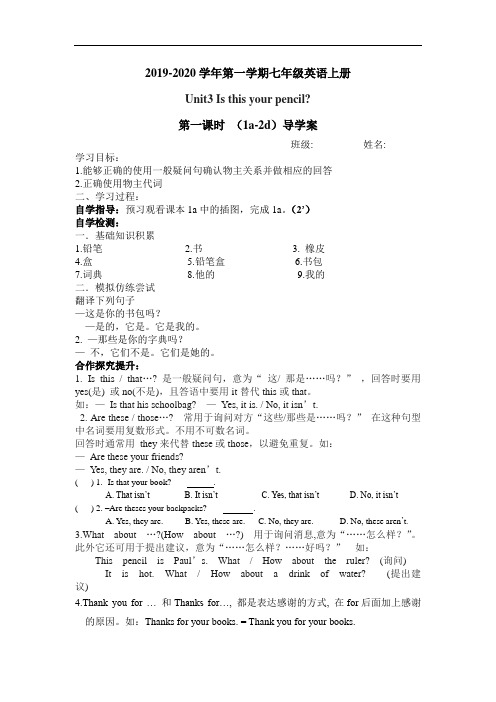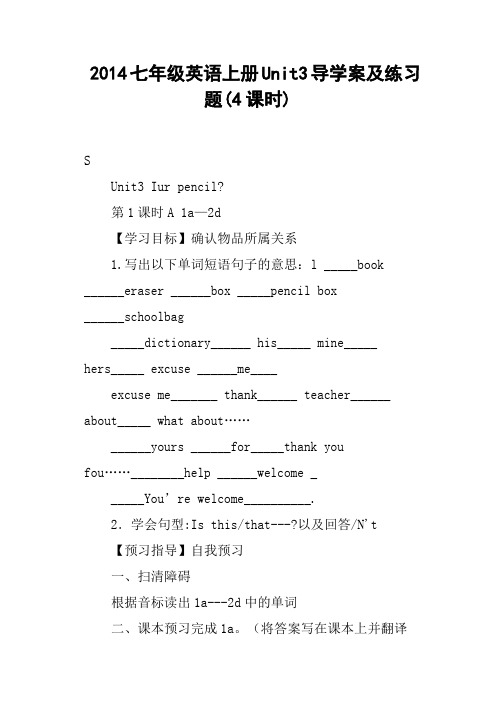Book 7 Unit3导学案
- 格式:doc
- 大小:39.00 KB
- 文档页数:2

Unit3 Is this your pencil?第一课时(1a-2d)导学案班级:__________姓名:_______学习目标:1.能够正确的使用一般疑问句确认物主关系并做相应的回答2.正确使用物主代词二、学习过程:自学指导:预习观看课本1a中的插图,完成1a。
(2’)自学检测:一.基础知识积累1.铅笔_______________2.书_______________3. 橡皮_______________4.盒_________________5.铅笔盒___________6.书包_______________7.词典_______________8.他的_______________9.我的________________ 二.模拟仿练尝试翻译下列句子—这是你的书包吗?_______________________________________________ —是的,它是。
它是我的。
_______________________________________ 2. —那些是你的字典吗?___________________________________________ —不,它们不是。
它们是她的。
___________________________________合作探究提升:1.Is this / that…? 是一般疑问句,意为“这/ 那是……吗?”,回答时要用yes(是) 或no(不是),且答语中要用it替代this或that。
如:—Is that his schoolbag? —Yes, it is. / No, it isn’t.2. Are these / those…? 常用于询问对方“这些/那些是……吗?”在这种句型中名词要用复数形式。
不用不可数名词。
回答时通常用they来代替these或those,以避免重复。
如:—Are these your friends?—Yes, they are. / No, they aren’t.( ) 1. -Is that your book? - .A. That isn’tB. It isn’tC. Yes, that isn’tD. No, it isn’t ( ) 2. –Are theses your backpacks? - .A. Yes, they are.B. Yes, these are.C. No, they are.D. No, these aren’t.3.What about…?(How about…?)用于询问消息,意为“……怎么样?”。

Unit 3 Is this your pencil? Section A(1a-1c)[学习目标] 1、学会学习用品的英文表达。
2、运用形容词性物主代词和名词性物主代词来确认物品所属关系。
3、通过开展小组活动,提高解决问题的能力,教育学生养成良好的生活习惯,不乱放物品,避免丢失。
[学习重点] 1.形容词性物主代词和名词性物主代词的用法2.一般疑问句的肯定和否定回答[学习过程]自主预习重点词汇(默写,组内成员互改)1.书___________2.铅笔___________3.文具盒___________4.书包___________5.字典___________6.字典复数___________7.一块橡皮___________8.他的(名词性物主代词)___________9.我的(名词性物主代词)___________10.她的(名词性物主代词)___________合作探究1.例句:Is this a book? 这是一本书吗?Yes, it is. 是的,它是。
Is that your eraser? 那是你的橡皮吗?No, it isn’t. 不,不是。
这两个句子都是__________(一般/特殊)疑问句.在这种句型中名词要用_________(单数,复数)形式。
__________(this/that)用来询问较近的人或物, __________(this/that)用来询问较远的人或物。
肯定回答:___________否定回答:___________注意:答语不用this或that,而用_______代替this和that2.例句:Are these your pens? 这些是你的钢笔吗?No, they aren’t. 不是。
Are those his pencils? 那些是他的铅笔吗?Yes, they are. 是。
Are these/those …? 这些/那些是……吗?在这种句型中名词要用_________(单数/复数)形式。

Unit 3 How do you get to school ?Period 1(Section A 1a~2c)自主学习课前诊断一.温故知新Ⅰ. 用两种方式说出下列时间。
1. 12:302. 9:453. 7:504. 8:205. 6:156. 7:08Ⅱ. 说出下列句子。
1. 他有很健康的生活。
2. 吉姆通常6点回家。
3. 你通常在星期六做作业吗?4. 那个妇女想买两台收音机。
5. 下课后咱们打扫教室吧!二、设问导读Ⅰ. Write these numbers in English (2a,2b).84 105 99 200 72Ⅱ. Translate the following phrases.1. 骑自行车2. 坐公共汽车3. 坐地铁4. 坐火车5. 步行上学Ⅲ. Pairwork.Dialogue 1A: How do you get to school?B: I …Dialogue 2A: How long does it take … ?B: It takes …Dialogue 3A: How far is it from … to … ?B: It’s about …互动学习问题解决how, how long , how far1. _______does ot take you from home to school ?About 5minutes .2. ______is it from your home to school ?About 2 kilometers.3.______does your brother get to school ?By bike .4. _____do you live from your school ?5._____does the bus ride take ?6.____old is your sister ?学用结合提高能力Ⅰ.单项选择( )1. —How do you ____ the park ?—I ____ a bus.A. get; byB. get to; takeC. get; take( ) 2. —Does your father go to work _________bus?—No, he ________his bike .A. by; byB. take; ridesC. by; rides( ) 3. —_______is it from your home to school?—It’s about 2 kilometers.A. HowB. How longC. How far( ) 4.—I walk to school.___________?—I walk to school, too.A. How about youB. How do you doC. How think ( ) 5. How long does it _______ you to go home?A. takeB. needC. getⅡ. 用英语单词完成下列算式1. 40+30=70 _____+_____=_____2. 12+26=38 _____+_____=_____3. 50+60=110 _____+_____=_____4. 18-6=12 _____-_____=_____5. 20+36=56 _____+_____=_____Ⅲ. 按要求完成句子,每空一词1.My father goes to work by bike.(对划线部分提问)your father to work?2.Mary goes to school by subway.(改为同义句)Mary the subway school.3.He often watches TV for two hours in the evening.(对划线部分提问)does he often watch TV in the evening?4.His dictionary is 50 dollars.(对划线部分提问)is his dictionary?5.This is her bike. (改为同义句)This bike is .课堂小节,形成网络填入适当的句子补全对话A: Hello, Bill.B: Hello, Mike.A: 1._____________?B:I get up at six.A: 2._____________?B: I have some bread for breakfast.A: 3._____________?B: No, I don’t like salad.A: 4._____________?B:I go to school by bus.A: And last question. 5._____________?B: My favourite subject is English.A: Thank you.B: You’re welcome.Unit3 How do you get to school ?Period 2(Section A 2e~3c)自主学习课前诊断一、温故知新Useful phrases:1.到校______________2.上班____________3. 到家_________________4. 到这儿________________________5. 到那儿______________6.去上学______________________________7.去上班____________________ 8.回家___________________9.去那儿______________________10. .乘地铁________________11.乘公共汽车______________12.乘火车_________________13. 乘飞机___________14.乘出租车________________________15.乘船________________16.骑自行车_________________17.步行_____________ 18.开车送他上学______________19.多远________________20.多久________________二、设问导读Ⅰ. Read 2e (P14) and complete the conversation.A: Hey, Jane. Is this your new bike?B: Yes. I ride it to school everyday. 1. ____________________A: I usually take the bus.B: 2. ____________________A: I’m not sure —about 10 kilometers? The bus ride takes about 20 minutes. 3. _________B: About 15 minutes by bike. It’s good exercises.A: Yeah, well, have a good day at school.B: You, too.Ⅱ. Read Grammar focus (P15). Then finish 3a and 3b (P15) with your partner.三、自学检测Ⅰ. Pairwork: Practice 2e (P14) with your partner and make your own conversation. Then act it out.Ⅱ. 单项选择( ) 1.—Is this bike________?—No, it’s not ________.A. your; mineB. yours; mineC. your; my( ) 2. —When do they get _______ Beijing?—They get ________ there at 8:00.A. to; toB. / ; /C. to; /( ) 3. The _________takes about _________ hour.A. bus ride; anB. bus ride; aC. ride bus; an( ) 4. Going to school by bike is _________.A. a good exercise.B. good exercises.C. good exercise.( ) 5.—Does she take the bus to school?—_________.She goes by bike.A. Yes, she doesB. No, she doesn’tC. I’m not sure互动学习问题解决用take 填空。

七年级上册英语unit3 导学案(整理版)七年级上册英语unit3导学案(整理版)这是你的铅笔吗?第1节A1A-1c【学习目标】:1、掌握词汇pen,pencil,book,ruler,eraser,backpack,pencilbox,dictionary等2.学习句型:是这个/那个-?回答是,是/否,不是。
[学习重点]:掌握指示代词的用法:形容词所有格代词和名词所有格代词[学习过程]:一、自主学习(教师寄语:knowledgeispower.)学习任务1:掌握钢笔、铅笔、书、尺子、橡皮擦、背包、,pencilbox,,dictionary等1.仔细观察1a的图片,将单词与图片中的项目匹配,分组讨论并检查答案。
2.试着独立阅读,并在小组中纠正彼此的发音。
3.老师引导阅读,学生纠正发音。
4.自己阅读并记住中文意思,并在小组中进行核对学习任务二:学会句型:isthis/that---?以及回答yes,itis./no,itisn't.从而掌握指示代词:这个,那个1.先唱以下歌谣:我的my,你的your,男的his,她的her名词前面通常有一个guard,它定义了它所属的信用。
复习形容词所有格代词my,your,his,HER2使用宾语介绍句型:isthis/that-?使用不同的项目来练习我的,你的,他的,这里t:ThisisMy。
这是你的钢笔吗?s1:no,itisn't.it'syourpen/yours.etc.在口语中综合练习两种物主代词。
3.听录音,给1b对话编号4.练习1b中的对话。
用你所有的项目组成一个新的对话,并分组展示。
2、一起写一段对话,确认项目,并在课堂上进行交流和展示。
3、系统总结(老师的信息:任何人一次只能做两件事。
)物主代词是表示所属关系的代词分为形容词性物主代词和名词性物主代词。
名词形容词所有格代词单数MyYourHisher复数OurYour名词所有格代词单数myyourhisherits-1-1.形容词性物主代词相当于形容词放在名词之前起修饰限定作用。

Unit 3 How do you get to school ?学习目标1.学会谈论交通工具和距离||。
2.学会合理安排行程||,并合理选用交通工具||。
重点难点1.学习并掌握how /how far /how long 引导的特殊疑问句.2.掌握乘坐交通工具的表示方法和相应的句型3.掌握并熟练运用句型:It takes /will take/took sb some time to do sth .Period One (Section A 1a—1c)学习目标1.谈论如何到达某地||。
2.学会用how 来问路||。
3.熟记本节课的单词和短语||。
重点难点学习how对交通方式提问的特殊疑问句及答语||。
导学过程二、自主学习、合作探究(一)自主学习1.朗读1a短语||,完成1a.2.练习对话:---How do you get to school ? ---I get to school…/ I take the … to school.---How does he / she get to school ?---He / She gets to school … / He /She takes the …to school.3.完成1b 听力||,核对答案||。
(二)合作探究1.小组合作自编对话并展示||。
2.疑问词howhow 为疑问副词||,意为如何||,怎么||,以何种方式||,本句用以询问交通方式||,其回答方式有两种||,一种是直接用方式状语来回答||,即by+交通工具||,或in/on+限定词+交通工具;另一种用动词来回答||,如walk步行||,take+限定词+交通工具||,乘某种交通工具||,ride a bike||,骑自行车||,drive a car开车等||。
除此之外||,how还用以询问程度或方法等||。
3.take the +交通工具用来表示“乘……”相当于by +交通工具如:I usually take the bus to work. = I usually go to work _____ _____.take the train to school = go to school ____ _____walk to school= go to school ____ _____三、达标检测:(一)选择题( ) 1. -----How does your sister get to school? ----_______A. Once a dayB. Two milesC. Take a busD. Twenty minutes ( ) 2. My sister_________the bus to school everyday.A. onB. byC. takesD. ride( ) 3. ------_________ ----- By bus.A. Why does he go to work?B. How does he go to work?C. When does she go to work?( ) 4. I usually go to school ___ bike||,but sometimes I go to school ___foot.A. with||,onB. on||,byC. by||,on( ) 5. Do you usually go to school ____bus or _____foot? I walk to school.A. by||,onB. by ||,byC. on||,by(二)句型转换1.He takes a bus to school .(同义句)He gets to school ________ _________ .2.I get to work by boat . (划线部分提问)_______ ________you get to work ?3. They go to Changsha by train. (改为同义句)They _________ __________ _________ to Changsha.4.Linda sometimes takes the subway to school. (改为一般疑问句)_________ Linda sometimes ________the subway to school?课后反思Period Two (Section A 2a—2e)学习目标学习谈论怎么到达一些地方及花费时间和距离||。

2014七年级英语上册Unit3导学案及练习题(4课时)SUnit3 Iur pencil?第1课时A 1a—2d【学习目标】确认物品所属关系1.写出以下单词短语句子的意思:l _____book______eraser ______box _____pencil box______schoolbag_____dictionary______ his_____ mine_____hers_____ excuse ______me____excuse me_______ thank______ teacher______ about_____ what about……______yours ______for_____thank youfou……________help ______welcome ______You’re welcome__________.2.学会句型:Is this/that---?以及回答/N't 【预习指导】自我预习一、扫清障碍根据音标读出1a---2d中的单词二、课本预习完成1a。
(将答案写在课本上并翻译成汉语)2.完成2d对话,熟读、翻译成汉语;自己仿写对话。
【课内学习】一、教材处理:检查1a 2d 的预习效果。
小组实物练习句型:T:TIur pen?:N't.It'2.听录音,完成1b,2a,2b,利用自己所有的物品小组编新对话。
【导学指导】(1)Is that/this …? 那/这是……?这是个一般疑问句句型,是用来确认物主关系的。
肯定回答:否定回答:N’t. 注意:答语不用this或that。
(2)A/those …? 这些/那些是……吗?在这种句型中名词要用复数式。
不用不可数名词.肯定回答:are.是的。
否定回答:Naren’t. 不是。
注意:不能用these或those来做简略回答。
(3)What about …? 意为“……怎么样?”, 相当于How ab out …?, 后面可接名词、代词或动词-ing形式。
2013~2014学年度上学期高二英语导学案必修 6 Unit3 No. 6 姓名:小组:使用时间:2013,10,6. 小组评价:教师评价:Period 6 Grammar 语法导学案编写人:牛少飞审核人:核心组审批人:_____________ 领导签字:_____________【学习目标】1、理解并掌握动词ing的被动语态用法。
2、运用动词ing的被动语态相关知识完成句子。
3、用饱满的激情疯狂记忆,挑战自我,积极展示,享受学习的快乐。
【使用说明及学法指导】仔细阅读语法细则,用红笔标出重点,熟记虚拟语气在条件状语从句中的各种用法。
一.动词ing形式的被动语态的构成形式:动词ing形式的被动形式有一般式和完成式两种形式,即being done和having been done。
一般式表示一个被动的动作正在进行或与谓语动词的动作同时发生;完成式表示的动作发生在谓语动词所表示的动作之前。
例如:①That building being repaired is our library.正在维修的那座大楼是我们的图书馆。
②I appreciated having been given the chance to study abroad two years ago.我非常感激两年前获得了去国外学习的机会。
Ⅱ.动词ing形式的被动语态的用法1)作主语①Being punished by the headmaster made Jim unhappy.受到校长的惩罚使吉姆很不高兴。
②It's fun being taken to the zoo.被带去动物园真有意思。
2)作宾语I forget once being taken to the seaside when I was young.我忘了小时候曾被带到海边。
3)作表语What made his parents happy was his being admitted to a famous university.让他父母高兴的是他被名牌大学录取了。
Unit 3 导学案 No----【学习目标】1.牢固掌握Unit 3中重点单词、短语、句型。
12.通过独立思考和小组合作, 能灵活运用指示代词、人称代词和名词的单复数。
3.积极面对生活,真诚对待家人和朋友,享受亲情快乐,全力以赴,激情投入,享受学习的快乐!【重难点】 1.介绍他人。
2.人称代词he,she,it的用法。
3.少数名词复数的运用。
4.根据信息辨别人物。
5.了解写信的基本格式。
【能力培养】能灵活运用所学知识,提高自己英语交际的能力。
【使用说明】提前下发导学案,根据要求预习课文完成导学案上的内容,标出疑难点准备上课小组讨论解决。
【学法指导】1. 充分预习,熟读课文,认真研究导学案。
运用好双色笔,在课本上划出重点单词短语句型,标注出自己不懂的问题。
2. 自主完成,规X书写,独立思考;小组合作探讨,答疑解惑。
The first period(SectionA 1a—1c) .自学导航:预习Section A(1a—1c)的单词,注意读音及拼写。
一. 通过预习,写出画线单词的对应词。
1. Ben is my brother. Alice is my______.2. Mr Smith is her father. Mrs Smith is her______.3. This is a ruler and ______is a pencil.4. These are my brothers and _____are my sisters.5. He is my grangfather. She is my_______.二. 预习后,选用this,that,these或those填空.1. Mom,_____is my English teacher,Miss Gao.2. What is_____over there(在那边)?_____is a baseball.3. Are______your keys ? Yes,they are.4. Are______your pencils ? No,these are my pencils.5. A:Hello,____is Jane. Is____Peter? B: Yes,Peter speaking.三. 预习简单的名词复数形式,并写出下列词的复数.The second period (Section A 2a-4)一. Listen and fill in the blanks.Dave:___ ____my ______.Mom, this is Lin Hai.Lin Hai:Nice to meet you!Mom:Nice to meet you ,Lin Hai!Dave:And____ _____my ________.Grandparents:Hi,Lin Hai!Dave:And this is my ________,Mary, and this is my _______,Jim.二.预习并用所给单词的适当形式填空.1.Mr Smith is our English teacher.______(he) is 30. This is_____ (he)book.2.Is______(she) name Ann? Yes,it is.3.________(I)am Paul.Dave is_____(I) friend.4.Those_______(be)my brothers,and that_______(be) my sister.5.Is this your sister ? No, _______isn’t.三.复习二单元,预习Page15,你会以下句型转换吗?1.These are his pens. (改为一般疑问句)2.It is a pencil case. (对画线部分提问)3.Is Kate a good girl? (作肯定和否定回答)4.They are sisters. (改为否定句)5.Is that your ruler? (作肯定和否定回答)The third period (Section B 1-2c)一. 预习单词,根据句意及首字母提示完成句子.1. Dave is my uncle’s son. He is my c______.2. Kate is my sister. She is my mother’s d______.3. Tom is my father’s brother. He is my u________.4. Jim is my father’s son. He is my b________.5. My mother’s mother is my g____________.二.听填信息.Dave:This is my _______,and this is my ________.Lin Hai: And is _____ your ________?Dave:Yes, and those are ________ __________.三.句型转换.1.I am her daughter.(改为同义句.) She_____ _______ ________.2.This is my friend. (变为复数形式)3.That is his eraser. (变为复数形式)*4.These are her oranges.(变为单数形式)5.What are these in English? (变为单数形式)The fourth period (Section B 3a-Self check)一. 在预习过程中找出你认为的重点短语句型,注意下面短语或句子.……而感谢________3.这儿有(这是……二.预习写信的基本格式,完成3b,找一X你家人的照片,并写一封短信谈谈这幅照片.完成P18.的检测题._________1.Who are this girl?_________2.This is my sister ,my mother’s sister._________3.Is this your cousin? Yes, he is._________4.Thanks you for your help._________5.They are my grandparent.四. 单项选择.( )3.These aren’t my pens.______are my pens. A.These B.They C.Those D ThemUnit 3 复习案一.语言知识点运用与拓展。
Book 7 Unit 3 Under the Sea《Period 1 Vocabulary Study》导学案编写:王红英审校:黄定虎【学习目标】1. To learn the new words and expressions of Unit 22. To learn to use the words and expressions【学习重点】words and expressions in bold【学习难点】How to use the important words correctly1.I thought,at the time,that this was just a story but then I witnessed it with my own eyes many times.当时我以为这只是一个故事罢了,但是后来我亲眼见过很多次。
【归纳拓展】witness vt.当场见到,目击;作证,见证;n.目击者;证人;证据witness表示―作证,证明‖时,常用witness to sth./doing sth.be (a) witness to...目击,看见bear/give witness (to sth.)(为……)作证;证明【语境助记】(1)One witness to the accident said the driver appeared to bedrunk.这次事故的一个目击者说司机看上去喝醉了。
(2)His good health is a witness to the success of the treatment.他的健康状况是治疗成功的见证。
(3)The year 1849 witnessed a great war in Hungary. 1849年匈牙利经历了一场伟大的战争。
【题组训练】(1)Many people ,so it was not difficult to investigate. 很多人目击了这次车祸,所以调查并不难。
仁爱版英语七年级下册Unit 7 Topic 3 Section A课文1a重点短语与句型:at the party在聚会上play the piano弹钢琴perform magic tricks玩魔术(play tricks on sb捉弄某人)enjoy oneself玩得开心1. -How was Kangkang's birthday party? 康康的生日聚会怎么样?-It was very nice.非常好。
2. -Did you sing a song at the party? 你在聚会上唱了歌吗?-Yes, I did.是的,我唱了。
3. -What did Sally do? 莎莉做了什么?-She danced.她跳了舞。
4. -Did Kangkang enjoy himself?康康玩得高兴吗?-Of course. He was happy. 当然。
他非常高兴。
【知识点拨】(oneself反身代词—myself—yourself—himself—herself—ourselves—yourselves—themselves)上周我们玩得很开心。
eg: He enjoys playing basketball. 他喜欢打篮球。
2. 一般过去时:表示过去某个时间发生的动作或存在的状态。
动词的过去式的形式: 1). be动词(was/ were)2). 实义动词的过去式(规则变化和不规则变化)变化规则: A. 一般在动词原形末尾加-ed. 如: play-playedB. 结尾不发音字母e结尾加-d. 如: live- livedC. 末尾只有一个辅音字母的重读闭音节词,双写末尾辅音字母,再加-ed. 如: stop- stoppedD. 结尾是辅音字母+y结尾的动词,改y为i,再加-ed. 如: study- studied时间状语: yesterday 昨天,last year 去年,in 2000在2000年,three days ago 三天前,just now 刚刚,in those days 在那些日子里句式变化:1). A. 肯定句: 主语+ was/were + 其他。
选修7 Unit 3 Under the Sea
Reading Old Tom the Killer Whale导学案
Step 1 Fast Reading
Get the main ideas of the two anecdotes
The first anecdote describes a __________experience about how_______________________ _______________________________________________________________________ The second anecdote tells about how________________________________________.
Step 2 Careful –reading
Ⅰ.Scan the text and put the following sentences into a right order.
( ) George started beating the water with his oar
( ) Clancy jumped into the boat with the whalers and headed out into the bay. ( ) Clancy arrived at the whaling station
( ) The killers started racing between our boat and the whale
( ) Clancy heard a huge noise coming from the bay
( ) Clancy was sorting out his accommodation
( ) A whale was attacked by a pack of killers.
( ) The man in the bow of the boat aimed the harpoon at the whale
Ⅱ.Answer the questions.
2. What other animals did the author compare the killer whales with? Why do you think the killer whales behaved like this?
3. Why did George think that the killer whales worked as a team?
4. Why did the whalers allow the killer whales to drag the whale away?
5. What happened to James one day? How did Old Tom help James? Why do you think he did this?
Step 3 Discussion
1.In groups, describe the relationship between Old Tom and the whalers. What other animals help out humans in hunting?
2.The last whaling station in Australia closed in 1978. Whales are now an endangered species and in need of conservation. They are now protected by an international ban on whaling. However, some countries oppose the ban. In groups discuss the reasons for and against banning whaling.。